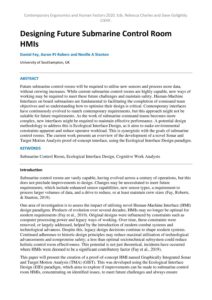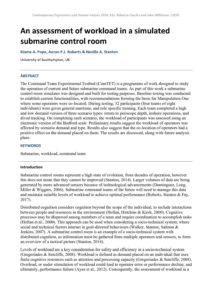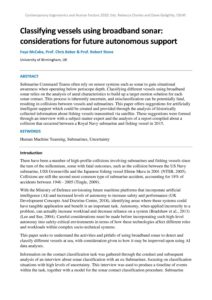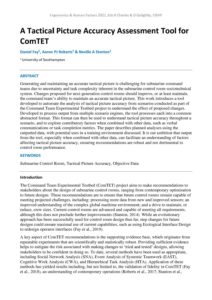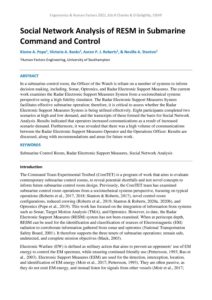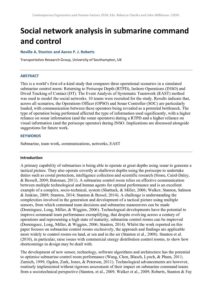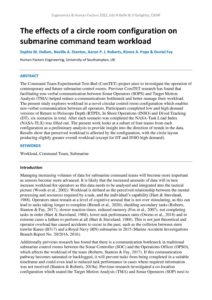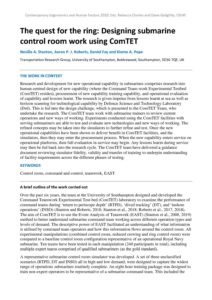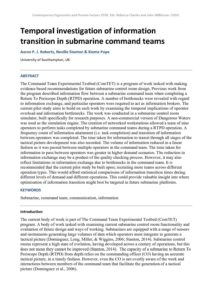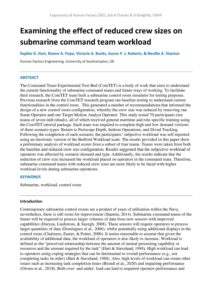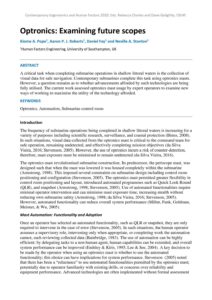Submarines
Designing Future Submarine Control Room HMIs
| Document | Author Daniel Fay, Aaron PJ Robers and Neville A Stanton |
| Abstract Future submarine control rooms will be required to utilise new sensors and process more data, without crewing increases. While current submarine control rooms are highly capable, new ways of working may be required to meet these future challenges and maintain safety. Human-Machine Interfaces on board submarines are fundamental to facilitating the completion of command team objectives and so understanding how to optimise their design is critical. Contemporary interfaces have continuously evolved to match contemporary requirements, but this approach might not be suitable for future requirements. As the work of submarine command teams becomes more complex, new interfaces might be required to maintain effective performance. A potential design methodology to address this is Ecological Interface Design, as it aims to make environmental constraints apparent and reduce operator workload. This is synergistic with the goals of submarine control rooms. The current work presents an overview of the development of a novel Sonar and Target Motion Analysis proof-of-concept interface, using the Ecological Interface Design paradigm. |
An assessment of workload in a simulated submarine control room
| Document | Author Kiome A. Pope, Aaron P.J. Roberts & Neville A. Stanton |
| Abstract The Command Team Experimental Testbed (ComTET) is a programme of work designed to study the operation of current and future submarine command teams. As part of this work a submarine control room simulator was designed and built for testing purposes. Baseline testing was conducted to establish current functionalities, with recommendations forming the basis for Manipulation One where some operators were co-located. During testing, 32 participants (four teams of eight individuals) were given general maritime, and role specific training. Each team completed a high and low demand version of three scenario types: return to periscope depth, inshore operations, and dived tracking. On completing each scenario, the workload of participants was assessed using an electronic version of the Bedford scale. Preliminary results suggest the workload of operators was affected by scenario demand and type. Results also suggest that the co-location of operators had a positive effect on the demand placed on them. The results are discussed, along with future analysis plans. |
Classifying vessels using broadband sonar: considerations for future autonomous support
| Document | Author Faye McCabe, Prof. Chris Baber & Prof. Robert Stone |
| Abstract Submarine Command Teams often rely on sensor systems such as sonar to gain situational awareness when operating below periscope depth. Classifying different vessels using broadband sonar relies on the analysis of aural characteristics to build up a target motion solution for each sonar contact. This process is inherently uncertain, and misclassification can be potentially fatal, resulting in collisions between vessels and submarines. This paper offers suggestions for artificially intelligent support which could be created and provided through the analysis of historically collected information about fishing vessels transmitted via satellite. These suggestions were formed through an interview with a subject matter expert and the analysis of a report compiled about a collision that occurred between a Royal Navy submarine and fishing vessel in 2015. |
A Tactical Picture Accuracy Assessment Tool for ComTET
| Document | Author Daniel Fay, Aaron PJ Roberts & Neville A Stanton |
| Abstract Generating and maintaining an accurate tactical picture is challenging for submarine command teams due to uncertainty and task complexity inherent in the submarine control room sociotechnical system. Changes proposed for next-generation control rooms should improve, or at least maintain, the command team’s ability to maintain an accurate tactical picture. This work introduces a tool developed to automate the analysis of tactical picture accuracy from scenarios conducted as part of the Command Team Experimental Testbed project to understand the effect of proposed changes. Developed to process output from multiple scenario engines, the tool processes each into a common abstracted format. This format can then be used to understand tactical picture accuracy throughout a scenario, and to explore contributory factors when combined with other data, such as verbal communications or task completion metrics. The paper describes planned analyses using the outputted data, with potential uses in a training environment discussed. It is our ambition that output from the tool, especially when combined with other data, can facilitate an understanding of factors affecting tactical picture accuracy, ensuring recommendations are robust and not detrimental to control room performance. |
Social Network Analysis of RESM in Submarine Command and Control
| Document |
|
|
| Abstract In a submarine control room, the Officer of the Watch is reliant on a number of systems to inform decision making, including, Sonar, Optronics, and Radar Electronic Support Measures. The current work examines the Radar Electronic Support Measures System from a sociotechnical systems perspective using a high fidelity simulator. The Radar Electronic Support Measures System facilitates effective submarine operation; therefore, it is critical to assess whether the Radar Electronic Support Measures System is being utilised effectively. Eight participants completed two scenarios at high and low demand, and the transcripts of these formed the basis for Social Network Analysis. Results indicated that operators increased communications as a result of increased scenario demand. Furthermore, it was revealed that there was a high volume of communications between the Radar Electronic Support Measures Operator and the Operations Officer. Results are discussed, along with recommendations and areas for future work. |
Social network analysis in submarine command and control
| Document | Author Neville A. Stanton and Aaron P. J. Roberts |
| Abstract This is a world’s first-of-a-kind study that compares three operational scenarios in a simulated submarine control room: Returning to Periscope Depth (RTPD), Inshore Operations (INSO) and Dived Tracking of Contact (DT). The Event Analysis of Systematic Teamwork (EAST) method was used to model the social networks. 10 teams were recruited for the study. Results indicate that, across all scenarios, the Operations Officer (OPSO) and Sonar Controller (SOC) are particularly loaded, with communication between these operators being revealed as a potential bottleneck. The type of operation being performed affected the type of information used significantly, with a higher reliance on sonar information (and the sonar operators) during a RTPD and a higher reliance on visual information (and the periscope operator) during INSO. Implications are discussed alongside suggestions for future work. |
The effects of a circle room configuration on submarine command team workload
| Document | Author Sophie M. Hallam, Neville A. Stanton, Aaron P. J. Roberts, Kiome A. Pope & Daniel Fay |
| Abstract The Command Team Experimental Test-Bed (ComTET) project aims to investigate the operation of contemporary and future submarine control rooms. Previous ComTET research has found that facilitating non-verbal communication between Sonar Operators (SOPS) and Target Motion Analysts (TMA) helped reduce a communications bottleneck and better manage their workload. The present study explores workload in a novel circular control room configuration which enables non-verbal communication between all operators. Participants completed low and high demand versions of Return to Periscope Depth (RTPD), In Shore Operations (INSO) and Dived Tracking (DT), six scenarios in total. After each scenario was completed the NASA-Task Load Index (NASA-TLX) was filled out. The present work looks at a subset of four teams from each configuration as a preliminary analysis to provide insight into the direction of trends in the data. Results show that perceived workload is affected by the configuration, with the circle layout producing slightly greater overall workload (except for DT and INSO high demand). |
The quest for the ring: Designing submarine control room work using ComTET
| Document | Author Neville A. Stanton, Aaron P. J. Roberts, Daniel Fay and Kiome A. Pope |
| Abstract Research and development for new operational capability in submarines comprises research into human centred design of new capability (where the Command Team-work Experimental Testbed (ComTET) resides), procurement of new capability training capability, and operational evaluation of capability and lessons learnt. The research is given impetus from lessons learnt at sea as well as horizon scanning for technological capability by Defence Science and Technology Laboratory (Dstl). This is fed into the design challenge, which is presented to the ComTET Team, who undertake the research. The ComTET team work with submarine trainers to review current operations and new ways of working. Experiments conducted using the ComTET facilities with serving submariners are able to test and evaluate new technologies and new ways of working. The refined concepts may be taken into the simulators to further refine and test. Once the new operational capabilities have been shown to deliver benefit in ComTET facilities, and the simulators, then they may enter the procurement process. When the new capability enters service on operational platforms, then full evaluation in-service may begin. Any lessons learnt during service may then be fed back into the research cycle. The ComTET team have delivered a guidance document reviewing simulator fidelity, validity and transfer of training to underpin understanding of facility requirements across the different phases of testing. |
Temporal investigation of information transition in submarine command teams
| Document | Author Aaron P. J. Roberts, Neville Stanton & Kiome Pope |
| Abstract The Command Team Experimental Testbed (ComTET) is a program of work tasked with making evidence based recommendations for future submarine control room design. Previous work from the program described information flow between a submarine command team when completing a Return To Periscope Depth (RTPD) operation. A number of bottlenecks were revealed with regard to information exchange, and particular operators were required to act as information brokers. The current pilot study aims to build on such work by examining the temporal implications of operator overload and information bottlenecks. The work was conducted in a submarine control room simulator, built specifically for research purposes. A non-commercial version of Dangerous Waters was used as the simulation engine. The creation of networked workstations allowed a team of nine operators to perform tasks completed by submarine command teams during a RTPD operation. A frequency count of information attainment (i.e. task completion) and transition of information between operators was completed. The time taken for information to transit through all stages of the tactical picture development was also recorded. The volume of information reduced in a linear fashion as it was passed between multiple operators in the command team. The time taken for information to pass between operators was greater in higher demand scenarios. The reduction in information exchange may be a product of the quality checking process. However, it may also reflect limitations in information exchange due to bottlenecks in the command team. It is recommended that the current pilot study be built upon; recruiting more teams across different operation types. This would afford statistical comparisons of information transition times during different levels of demand and different operations. This could provide valuable insight into where optimisation of information transition might best be targeted in future submarine platforms. |
Examining the effect of reduced crew sizes on submarine command team workload
| Document | Author Sophie G. Hart, Kiome A. Pope, Victoria A. Banks, Aaron P. J. Roberts & Neville A. Stanton |
| Abstract The Command Team Experimental Test-Bed (ComTET) is a body of work that aims to understand the current functionality of submarine command teams and future ways of working. To facilitate their research, the ComTET team built a submarine control room simulator for testing purposes. Previous research from the ComTET research program ran baseline testing to understand current functionalities in the control room. This generated a number of recommendations that informed the design of a new control room configuration, whereby the crew size was reduced by removing one Sonar Operator and one Target Motion Analyst Operator. This study tested 70 participants (ten teams of seven individuals), all of which received general maritime and role-specific training using the ComTET tutorial package. Each team was required to complete high and low demand versions of three scenario types: Return to Periscope Depth, Inshore Operations, and Dived Tracking. Following the completion of each scenario, the participants’ subjective workload was self-reported using an electronic version of the Bedford Workload scale. The results provided in this paper show a preliminary analysis of workload scores from a subset of four teams. Teams were taken from both the baseline and reduced crew size configuration. Results suggested that the subjective workload of operators was affected by scenario demand and type. Additionally, the results indicate that the reduction of crew size increased the workload placed on operators in the command team. Therefore, submarine command teams with reduced crew sizes are more likely to be faced with higher workload levels during submarine operations. |
Optronics: Examining future scopes
| Document | Author Kiome A. Pope, Aaron P. J. Roberts, Daniel Fay and Neville A. Stanton |
| Abstract A critical task when completing submarine operations in shallow littoral waters is the collection of visual data for safe navigation. Contemporary submarines complete this task using optronics masts. However, a question remains as to whether advancements afforded by such technologies are being fully utilised. The current work assessed optronics mast usage by expert operators to examine new ways of working to maximise the utility of the technology afforded. |

